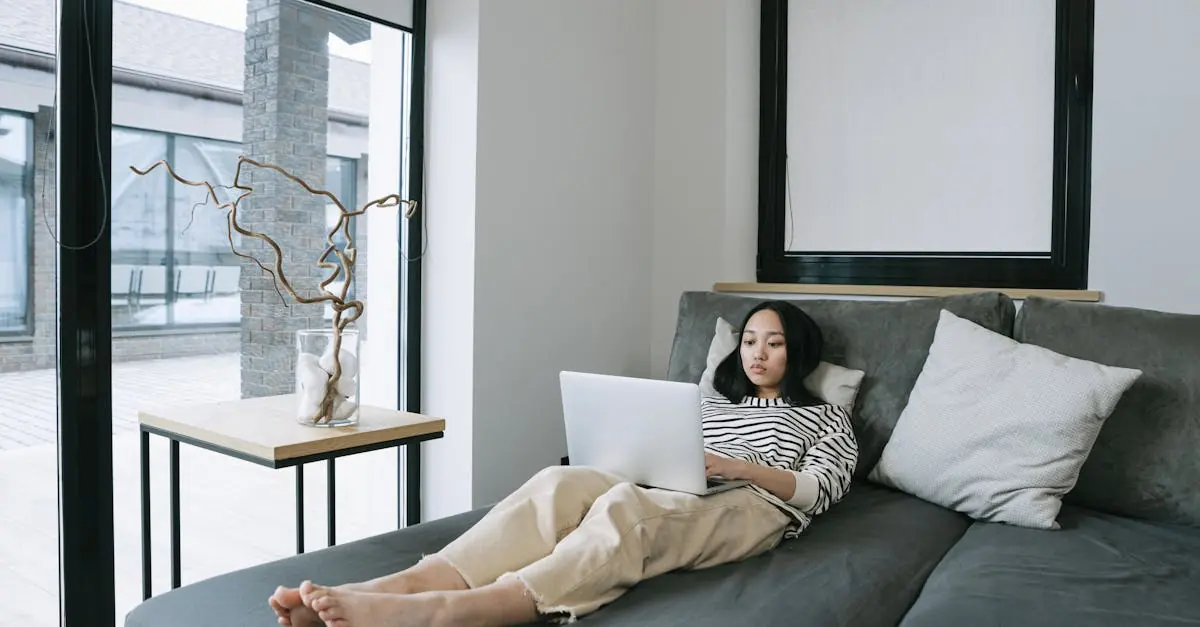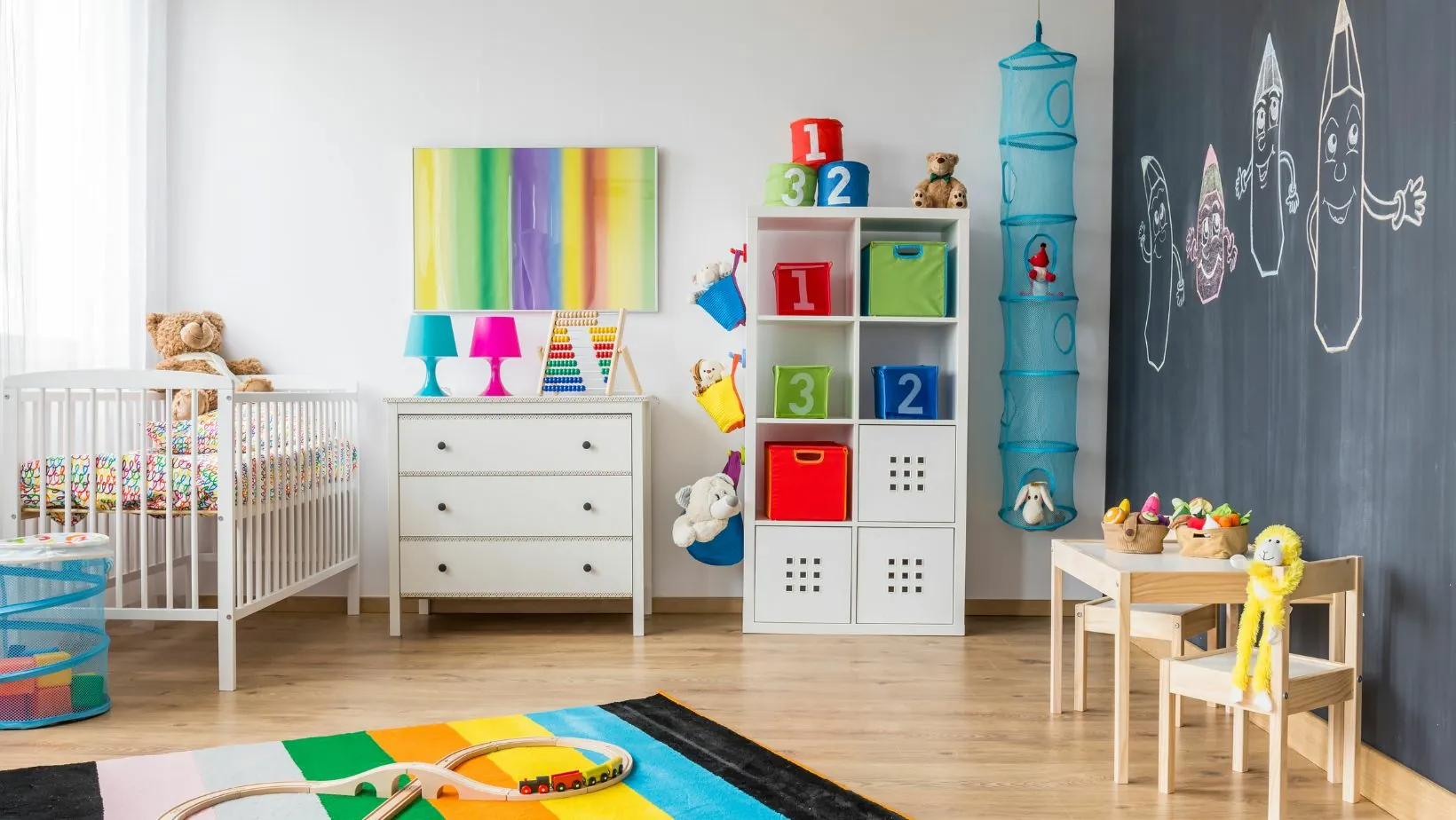Table of Contents
ToggleImagine stepping into a living room that feels like a breath of fresh air—no clutter, no chaos, just pure bliss. Minimalist living rooms aren’t just a trend; they’re a lifestyle choice that brings peace and serenity to everyday life. It’s like a spa day for your home, where every piece of furniture has a purpose and every decoration sparks joy.
Understanding Minimalist Living Room Aesthetics
Minimalist living room aesthetics focus on simplicity and functionality. These spaces cultivate a sense of tranquility and intentionality, making design choices deliberate and meaningful.
Key Principles of Minimalism
Designing a minimalist living room revolves around essential principles. Use a neutral color palette to promote calmness. Choose furniture that doubles as storage to maintain an organized appearance. Prioritizing open spaces allows for natural light to enhance the ambiance. Incorporate texture through natural materials, adding depth without clutter. Aim for a limited number of decorative items, each with a purpose or personal significance.
Importance of Simplicity in Design
Simplicity plays a critical role in minimalist design. Emphasizing clean lines creates a modern, airy feel. It’s important to select quality over quantity, choosing well-made pieces that endure. Fewer items lead to easier maintenance and greater focus on the living experience. Minimalism encourages individuals to appreciate the beauty of less, fostering a stronger connection between occupants and their environment.
Essential Elements of a Minimalist Living Room
Creating a minimalist living room focuses on key elements that promote simplicity and function.
Furniture Selection
Selecting furniture plays a crucial role in achieving a minimalist aesthetic. Each piece should serve a dual purpose, such as a coffee table with storage capability. Sofas with sleek designs also contribute to the uncluttered look. Priority lies in choosing items made from high-quality materials that ensure longevity. Versatile seating options enhance comfort while maintaining space efficiency. Opting for low-profile furniture allows floor space to appear more expansive, creating an open feel.
Color Palette
The color palette significantly influences the overall ambiance of a minimalist living room. Neutral tones like whites, grays, and beiges establish a calming environment. Accent colors add a touch of personality without overwhelming the senses. Soft hues create a serene backdrop that enhances natural light. Consistency in color use across furniture and walls ensures coherence in design. Those aiming for a minimalist look often incorporate one or two accent colors to maintain visual interest.
Decorative Accessories
Decorative accessories should be kept to a minimum to maintain the minimalist ethos. Choosing a few thoughtfully selected pieces provides personality without cluttering the space. Artwork or sculptures that evoke emotion can be focal points without overpowering the room. Natural elements, like plants, introduce freshness and life. Prioritizing quality over quantity helps highlight each piece’s significance. Simple textures, such as a cozy throw blanket or a woven basket, can add warmth and comfort without disrupting the minimalist vibe.
Creating a Minimalist Living Room
A minimalist living room embodies tranquility and thoughtful design. Achieving this aesthetic requires strategic choices and intentional planning.
Space Optimization Techniques
Utilizing open space creates a sense of freedom and simplicity. Choose furniture that fits proportionately without overwhelming the area. Multi-purpose pieces enhance functionality, freeing up floor space and reducing clutter. Incorporate shelves to display items without crowding surfaces. Allow for clear pathways to promote ease of movement. Arranging furniture to face each other encourages conversation while maintaining minimalism. Use rugs to define areas, adding warmth without busy patterns. Notably, position large furniture away from walls to enhance fluidity and depth.
Tips for Decluttering
Establishing a clutter-free environment involves regular assessments of belongings. Start by sorting items into essentials, sentimental, and non-essential categories. Keep only those items that serve a purpose or evoke joy. Limit decorative accessories to a few high-quality pieces that reflect personal style. Employ storage solutions that blend seamlessly with the decor, such as ottomans or stylish baskets. Consider adopting a “one in, one out” policy, preventing clutter accumulation. Regularly evaluate spaces, ensuring that items remain functional and relevant to the minimalist ethos.
Lighting Considerations
Natural light plays a crucial role in establishing a calm atmosphere. Opt for sheer curtains to maximize sunlight while maintaining privacy. Incorporate varied lighting sources to enhance the room’s ambiance. Use floor and table lamps with simple designs to create focal points without overwhelming the senses. Consider using dimmer switches for adjustable lighting, allowing for a change in mood. Emphasize the use of warm tones to foster a cozy yet open environment. Strategically placed mirrors can reflect light, further brightening the space while enhancing depth.
Benefits of a Minimalist Living Room
A minimalist living room offers numerous advantages that enhance daily life. Clarity and simplicity characterize this space, allowing for a serene environment.
Enhanced Tranquility
Fewer items create a calming atmosphere, promoting relaxation. Visual clutter often leads to mental busyness, yet a minimalist approach reduces distractions. Each piece in the room contributes meaningfully, fostering a sense of harmony. Natural light filters in unobstructed, reinforcing the tranquil vibe. Serenity is heightened by a balanced design that invites peace into everyday routines.
Increased Functionality
Functionality shines in a minimalist living room, where each element serves a purpose. Multi-functional furniture, such as storage ottomans or compact tables, maximizes usability. Open spaces encourage movement and foster social interactions. Simplicity in decor aids organization, making it easier to maintain order. This optimized layout enhances efficiency, enabling seamless transitions between activities.
Conclusion
Embracing a minimalist living room transforms not just the space but also the way individuals interact with their environment. By prioritizing simplicity and functionality, it cultivates a serene atmosphere that enhances daily life. Thoughtful furniture choices and a neutral color palette create a calming backdrop, while intentional decor fosters emotional connections.
This design philosophy encourages a clutter-free lifestyle that promotes relaxation and harmony. With the right techniques for space optimization and maintenance, anyone can enjoy the benefits of a minimalist living room. Ultimately, it’s about celebrating the beauty of less and creating a sanctuary that reflects personal values and fosters tranquility.








